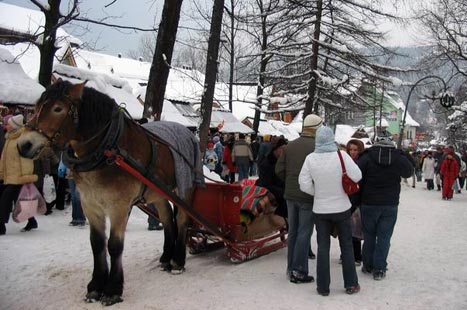Zakopane Town
Zakopane is nestled in a valley between the Tatra Mountains in the south and Gubalowka Hill to the north. Like most places in Poland, the town is in a state of flux at the moment as the free market economy moves into gear. It will be very interesting to see how the town develops - today Zakopane is a heady blend of the brazenly commercial and the wistfully old fashioned. However, there are plenty of surprises, making this a hard place to pigeon-hole, and this is very much part of it's slightly potty charm.
Nowhere is the commercial spirit more evident than on Krupowki - the long pedestrianized street that runs through the heart of the town. Krupowki runs north from the statue of the eccentric philanthropist, Count Ladislas Zamoyski, following a pleasant downhill gradient to the foot of Gulabowka Hill. This street is the main focus of the holiday trade, with a host of fairground type attractions. Big fast food chains rub shoulders with hearty Highland inspired restaurants, with their chunky wooden furnishings and folksy odds and ends. The preponderance of highland folk groups can verge on the comical at times, and in the evenings it seems that you can hardly open a door without bumping into jodphur attired trio playing the wistful strains of a gorale lovesong.

Away from the main streets you often feel that you are walking into a timewarp. It is in these quieter areas that the charm of old Zakopane can best be appreciated. In the 1890's Stanislaw Witkiewicz, one of the period's glorious eccentics, launched the 'Zakopane Style' - a movement that aimed to create a patriotic and beautiful national style of architecture, based on folk traditions. This was at a time when Polish culture was being forcibly repressed in much of the old Kingdom, and Zakopane, which lay in the comparitively liberal Austrian section, became a mecca for Polish thinkers.
The town has an abundance of elegant villas from this era, as can be found on the attractive Sienkiewicz street. This is also the case on Koscieliska, which leads west off the northern end of Krupowki. There you can find the delightful Museum of the Zakopane Style, which is located in Witkiewicz's first experiment in the idiom, the Villa Koliba. The museum also houses a wonderful collection of portraits by the great man's son, Witkacy, who arguably surpassed his father and has since become the stuff of legend.
On the same street you will also find the wonderful old wooden Church of St. Clement, which was the first parish church in Zakopane, founded in 1850. Behind it lies the magical and unique Old Graveyard - a quite extraordinary and thoroughly undepressing place.
Zakopane has plenty more surprizes, not least the rather fantastic museum of Wladyslaw Hasior, which is like stepping into the grotesque, enchanting world of children's fiction. And not to be forgotten is the renowned Witkacy Theatre, a popular haunt since it opened in 1985.
Leaving the distractions of the town behind, you can take a cable-car up Gubalowka Hill, which is one of the main gateways to the surrounding countryside.
Comments
Zakopane is fantastic. Town on Tatra mountains, wonderful highlanders culture, atmospheare!!! Great Zakopane style architecture in the town. Zakopane is TOP mountain resort in Tatras.
Replybeautiful town but woundn't recommend sitting directly behind the horse on the sleigh ride ,great fun though.
ReplyPlease tell the city fathers that they should remove or at least make much smaller those awful signs of KFC which grace the hotel in the center of town (across the post office). This is really a jarring sight in otherwise a very pretty town and an interesting street. This is commercialism of the "tackiest" kind. Will be grateful if you share this observations with the powers to be..
Reply